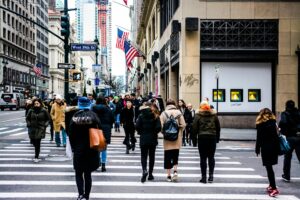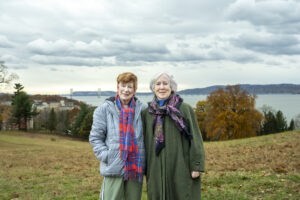
How can cities ensure that seniors stay active, independent, and socially engaged as they age? Walkable neighborhoods are a crucial part of the solution, providing older adults with safe, accessible routes to essential services, social spaces, and recreation.
With nearly 16.5% of the U.S. population now aged 65 or older, and this number expected to grow significantly by 2050, designing urban environments that meet the needs of seniors is more important than ever.
Walkability promotes physical health and mental well-being while fostering community connection, benefiting individuals and society alike.
Key Challenges Seniors Face with Walkability
Seniors encounter several physical barriers that hinder their ability to walk safely in urban areas. Research shows that 20-30% of older adults experience at least one fall annually, often due to uneven sidewalks, poorly maintained paths, or steep curbs.
These barriers are particularly hazardous for individuals using walkers or wheelchairs, contributing to the 28% of seniors who report falling each year. Cities with aging infrastructure that delay sidewalk repairs further increase the risk of injury for older adults.
Traffic-related risks are another significant challenge. According to the CDC, adults aged 65 and older represent about 20% of pedestrian fatalities in the U.S. Inadequate crosswalk timings often force seniors to rush, increasing their exposure to accidents.
Many urban areas lack sufficient crosswalks and rely on unsafe mid-block crossings. Without proper traffic-calming measures, fast-moving vehicles further exacerbate safety risks, making many public spaces inaccessible and dangerous for older adults.
Designing Age-Friendly Infrastructure

Creating safe, accessible infrastructure for seniors requires wide, well-maintained sidewalks with minimal elevation changes to reduce fall risks. The Department of Transportation suggests a minimum sidewalk width of five feet to accommodate mobility aids.
Regular sidewalk maintenance is also critical, as trip hazards such as cracks and tree roots disproportionately affect older adults. Curb ramps and tactile paving at intersections enhance accessibility for individuals with mobility or visual impairments.
Adjusting pedestrian signal times is another key improvement, reflecting the slower walking pace of seniors—typically 2.5 to 3.0 feet per second. Cities with longer crossing times, such as New York, report fewer accidents involving older pedestrians.
Rest areas, including benches placed every 300 to 500 feet, encourage outdoor activity and prevent fatigue during longer walks. Additionally, shaded walkways and accessible public restrooms make urban environments more inviting, promoting independence and participation in outdoor activities.
Technological Solutions for Safe Navigation
Smart crosswalks are a growing solution for improving senior mobility. These systems use sensors to detect pedestrians and automatically extend signal times when needed, reducing accidents. For example, Phoenix has started implementing smart intersections in several high-traffic areas, with promising results in lowering pedestrian fatalities.
In cases where accidents still occur, consulting a pedestrian accident lawyer in Phoenix can help victims and their families navigate legal complexities and pursue rightful compensation. Audible signals and vibrating cues at crosswalks also assist visually impaired seniors, making public spaces more accessible.
Senior-friendly navigation apps can provide real-time, step-by-step guidance, helping users navigate safely. These tools fill a crucial gap as older adults increasingly rely on smartphones for navigation.
Traffic-calming technologies, such as speed cameras and digital signage, enhance safety by encouraging drivers to slow down in senior-heavy areas. With the expansion of smart city initiatives, these technologies are becoming integral to creating safer, more walkable spaces for seniors.
Community-Led Walkability Initiatives

Community involvement is crucial for improving walkability. Cities like Portland and Minneapolis engage older residents in “walk audits,” where seniors identify hazards such as broken sidewalks, unsafe crossings, or inadequate rest areas. Data from AARP confirms that communities actively involving residents see higher satisfaction with pedestrian safety improvements, underscoring the importance of local input.
Partnerships between city governments, nonprofits, and senior advocacy groups further drive progress. Programs like WalkBoston promote awareness through organized walks while advocating for infrastructure improvements, such as benches and shade trees.
These initiatives not only enhance safety but also build social connections among participants, reducing isolation. Walking groups, in particular, offer exercise and foster a sense of community, improving overall quality of life for older adults.
Walkable Neighborhoods as Part of Aging-in-Place Strategies
Walkable neighborhoods are essential for aging in place, allowing seniors to maintain independence by reducing reliance on cars. About 77% of older Americans express a preference for staying in their homes as they age.
However, this requires communities with accessible sidewalks, local amenities, and public transportation. Mixed-use developments, where residential areas are integrated with shops and healthcare services, allow seniors to manage daily activities without long commutes.
Incorporating walkability into aging-in-place strategies also reduces healthcare costs by encouraging physical activity. Regular movement helps lower the risk of chronic illnesses such as heart disease and stroke.
Walkable neighborhoods also promote social interaction, which reduces the likelihood of depression and cognitive decline. By prioritizing these elements, cities can create environments where seniors remain active, healthy, and engaged in their communities well into old age.
Future Trends and Innovations in Walkable Cities for Seniors
Emerging technologies are transforming urban mobility for seniors. Autonomous shuttles, currently being tested in cities like Columbus, Ohio, offer door-to-door transportation within walkable areas, bridging gaps for those with limited mobility.
AI-powered monitoring systems, such as those in use in Toronto, dynamically adjust pedestrian signals and alert drivers when seniors are crossing, reducing accident risks. With the number of Americans aged 65 and older projected to reach 82 million by 2050, such innovations will become increasingly vital.
Urban design is also evolving, focusing on integrating micro-parks and pocket green spaces into neighborhoods. These small parks provide accessible places for rest and social interaction without requiring long travel.
In addition, smart benches equipped with solar chargers, shade, and emergency call buttons offer both safety and convenience for seniors. These innovations will help cities better serve their aging populations while fostering more inclusive, vibrant communities.
Conclusion
What makes a city truly livable for all ages? As the population continues to age, cities must prioritize walkability to ensure seniors remain active, independent, and connected to their communities.
Implementing accessible infrastructure, leveraging technology, and fostering community involvement are key strategies to achieve this goal. These improvements not only benefit seniors but also enhance urban spaces for everyone, creating healthier, more sustainable cities. By investing in walkable neighborhoods today, cities can build environments where residents of all ages thrive.






